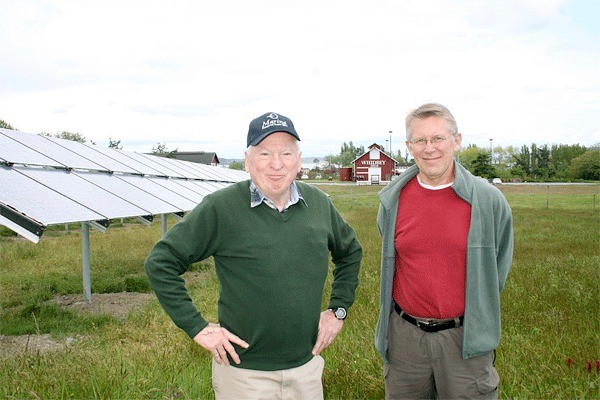The one-time largest grower of loganberries in the United States is tapping into something new.
Workers recently finished installing solar panel arrays at the publicly owned Greenbank Farm. The arrays, which are located between the farm buildings and the alpaca pasture, will produce 25.1 kilowatt hours, which is more than 26,000 kilowatt/hours per year.
John Hastings of Island Community Solar said the arrays will produce enough electricity to power approximately two-and-a-half energy-efficient homes per year.
It took workers four weeks to install the two lines of solar arrays.
“They got slowed down a bit because of the weather,” Hastings said of the workers’ efforts in the rain under gray skies.
The new panels are the culmination of a lengthy effort to get an alternative energy project established at the Greenbank Farm. The Port of Coupeville, which owns the commercial area of the farm, offered the land for the panels and Puget Sound Energy provided a $25,000 grant to help fund startup costs.
In addition, approximately $250,000 was raised over several months, Hastings said. People who invested dollars in the solar project will see a return in their money through a federal tax credit and production incentives for alternative energy funded by the state.
While the arrays are installed, they aren’t yet supplying any electricity to the grid. Puget Sound Energy first has to install a meter and a date hasn’t been set.
Plans are already being developed to expand the number of solar energy arrays at the Greenbank Farm.
“We hope the farm will get to a state of net zero energy where the farm produces as much energy as it consumes,” Hastings said Wednesday. He would like to expand the arrays to where they will produce 80 percent of the farm’s power while the tenants reduce their electricity usage by 20 percent.
He hopes to raise between $220,000 and $230,000 to pay for purchase and installation of arrays that will produce 25.1 kilowatt hours of electricity.
Jim Patton, executive director for the Port of Coupeville, said an educational kiosk still has to be constructed. That kiosk, which is a requirement of the grant, will explain the project to the numerous people who visit the farm.
Hastings said a commissioning event, which tentatively is scheduled for July 13, will take place to celebrate the new arrays. He’s inviting members from the Council of Governments, Puget Sound Energy, the Greenbank Farm Management Group, Northwest SEED, and Silicon Energy — which manufactures the panels — to the event.



